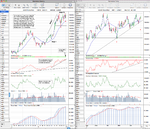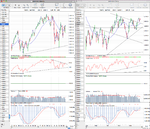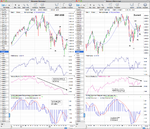Re: Sectors
. . .as the investor approach would not be very profitable over the several months as the market trend changes from up to down. I notice you are finding winning buys in a difficult market, so congratulations.
Isa, may I recap what is going on then, as I am getting confused by the daily and intraday.
On 10 Dec 11 page 18 you have a weekly SPX chart showing a falling 30 week MA, which turned some months ago.
Normally this would have been associated with a difficult time for trend traders.
You are then saying No you can combat this by choosing the best sectors, e.g. Tobac, Utils, Cons Staples, Healthcare. (What jumps out about these sectors are that they are dividend stocks, by the way, so this reflects a macro problem with growth stocks, which are the motor to a rising stockmarket.)
Another interpretation is that these sectors and stocks are just the star players in a meandering stockmarket, and you may not find they motor much.
To me, the stockmarket looks like mid 2008 pre Lehmans.
SPY Fund Charts - (NAR) SPDR S&P 500 ETF Trust Fund Charts
You have the long stage two rally, the topping process like started in late 2007, the turn down in the 30 week MA and the lower high. In early/mid 2008 there was a rally into the Lehmans news. There was lots of housing and banking worrying news at the time.
We have a good idea what the Lehmans equivalent news will be not so far away in 2012. In this scenario, aren't we, on a weekly "investor" basis, better sitting it out?
Alan Saunders at the time identified all these turns very early and very accurately, but, as you would expect, this did mean very few strong opportunities and difficult performance, as I remember it.
ShareHunter Unfortunately his blog goes back only to 2009, but I have looked back in my diary and he assessed around May 2008 as a bear market rally and one for sitting on hands. That is a feature of Weinstein, that you can have multi-month periods of difficulty and sitting on hands. Stop losses, by their nature in weekly trend following, have to be a good distance away, so you can't afford to get the big picture wrong.
For me, though, the big worry is the prospect of massive state intervention to prevent the consequences of EUR collapse, and this could send the stockmarket (and silver!) rocketing, against all the technical signs.



